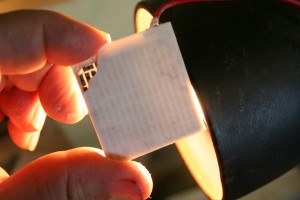Background:
A Peltier effect, thermoelectric device creates a temperature difference when a voltage is applied to it. The device is also thermodynamically reversible.
When the poles are reversed the hot side becomes the cold side and vice-versa.
Also these semiconductor devices have the Seebeck effect. Seebeck is the conversion of temperature differences directly into electricity and is named for German physicist Thomas Johann Seebeck in 1921. Apply heat to one side and cool the other and the leads will generate current.
- No Air-Conditioning: Air-con uses the same amount of power in an ICE car or a EV it is just less obvious in a normal car. Once the drain of air-con is realized many people decide that having the window open or using the fan alone are sufficient enough cooling for them. If range is a big priority and the temperatures of your area don’t get excessively hot then this is the simplest
and best option. - Dual Shaft Motor: If having AC is a must for your conversion then the option that is most similar to AC in a normal car is to run the AC compressor off the rear shaft of a dual shaft motor. The advantages are simplicity and similarity to standard cars but the AC will only work when the motor is spinning. This Saab is an example of using this approach.
- Accessory Motor: Another option is to run a small 12V accessory motor which is attached to the compressor. This approach allows AC to be used when the car is stationary and means that there is no direct drain on the power to the drive motor but adds weight and complexity. This Honda is an example of using this approach.
- Ice: Rather than storing electricity and using it to lower the temperature of the car it may be easier and cheaper to store a direct source of cooling; ice. Blowing air through an ice water mix is a rather effective form of cooling and might be sufficient for your cooling requirements. A DIY example can be seen here, or you may prefer Mr Sharkey’s no nonsense approach here.
- Compressor with integral motor: A more recent option is a compressor with a motor built in like your home AC unit. Some of the newer hybrids use this technology such as the Prius or this conversion which utilizes a variable speed control to maximize efficiency. With this option you also have more freedom as to where to locate the unit and you don’t have a lot of mounting hardware to fabricate. http://www.evdrive.com/BMW_project/AirConditioning.html Extension of the above is DC powered complete unit. Expensive , but compact. DC-Breeze is an example. ~$2,500 for 5,000 BTU / hr cooling all in a ~50 pound package… just plan for the ~580 Watt load to run it. Another integral motor option in 2011 is Cool Blue
Air Conditioning Compressor/Condenser Unit, using your original evaporator. - Seat Heater-Cooler:Like some new vehicle seats cool the drivers
backside. Thermoelectric cooling ( TEC ) technology. [Peltier]
(From an advertizement) Inside the seat pad there is 6 polyethylene tube flask in the fire proof material. 1/3 of the tube can be felt when human body touches the surface. And immediately you can feel cool or warm. The car seat cushion’s power consumption is 30W. Working continually 33 hours will consume 1 watt–hour electricity. The thermoelectric ( TEC) car seat cushion works in low safe 12V
voltage both it’s cool and warm function. The tube, which carries antifreeze, can bear 150Kg pressure. And there is a pump inside the power box that transfers cool or warm to the pad surface. The power system is separated from the seat itself. In low voltage condition it is very safe to use in normal. All the materials are fire resistant to ensure safety. The circulatory system is
airproof and no probability of leakage. Huimao China - ThermoElectric [[http://saturn.lynnautorepair.com/Testing%20the%20Option%20of%20ThermoElectric%20Air%20Conditioning%20for%20the%20Electric%20Car|(TEC) in dash device to replace the evaporator core.]] Do not need a compressor, hoses, expansion device, condensor or accumlator. This device along will remove heat, but will require some heat exchanger method to remove the heat from the TEC’s hot side
